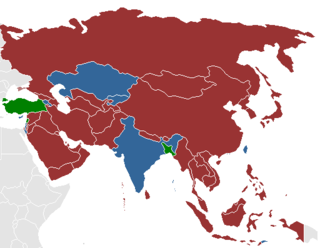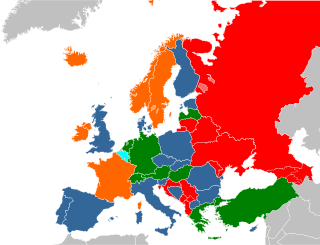Related Research Articles

Street prostitution is a form of prostitution in which a prostitute solicits customers from a public place, most commonly a street, while waiting at street corners or walking alongside a street, but also other public places such as parks, benches, etc. The street prostitute is often dressed in a provocative manner. The sex act may be performed in the customer's car, in a nearby secluded street location, or at the prostitute's residence or in a rented motel room.
Kamathipura is a neighbourhood in Mumbai, India known for prostitution. It was first settled after 1795 with the construction of causeways that connected the erstwhile seven islands of Mumbai. Initially known as Lal Bazaar, it got its name from the Kamathis (workers) of other areas of the country, who were labourers on construction sites. Due to tough police crackdowns, in the late 1990s with the rise of AIDS and government's redevelopment policy that helped sex workers to move out of the profession and subsequently out of Kamathipura, the number of sex workers in the area has dwindled. In 1992, Brihanmumbai Municipal Corporation (BMC) recorded there were 45,000 sex workers here which was reduced to 1,600 in 2009 and 500 in 2018. Many sex workers have migrated to other areas in Maharashtra with real estate developers taking over the high-priced real estate. In 2018 the Maharashtra government sought tenders to demolish and redevelop the area.

Prostitution in the Netherlands is legal and regulated. Operating a brothel is also legal. De Wallen, the largest and best-known Red-light district in Amsterdam, is a destination for international sex tourism.

Baltimore's The Block is a stretch on the 400 block of East Baltimore Street in Baltimore, Maryland, containing several strip clubs, sex shops, and other adult entertainment merchants. During the 19th century, Baltimore was filled with brothels, and in the first half of the 20th century, it was famous for its burlesque houses. It was a noted starting point and stop-over for many noted burlesque dancers, including the likes of Blaze Starr.

In Great Britain, the act of engaging in sex as part of an exchange of various sexual services for money is legal, but a number of related activities, including soliciting in a public place, kerb crawling, owning or managing a brothel, pimping and pandering, are illegal. In Northern Ireland, which previously had similar laws, paying for sex became illegal from 1 June 2015.

Prostitution is legal in India, but a number of related activities including soliciting, kerb crawling, owning or managing a brothel, prostitution in a hotel, child prostitution, pimping and pandering are illegal. There are, however, many brothels illegally operating in Indian cities including Mumbai, Delhi, Kolkata, Pune, and Nagpur, among others. UNAIDS estimate there were 657,829 prostitutes in the country as of 2016. Other unofficial estimates have calculated India has roughly 400,000 prostitutes. India is widely regarded as having one of the world's largest commercial sex industry. It has emerged as a global hub of sex tourism, attracting sex tourists from wealthy countries. The sex industry in India is a multi-billion dollar one, and one of the fastest growing.

Prostitution is illegal in the vast majority of the United States as a result of state laws rather than federal laws. It is, however, legal in some rural counties within the state of Nevada. Additionally, it is decriminalized in the state of Maine. Prostitution nevertheless occurs elsewhere in the country.
The Near North Side of Omaha, Nebraska is the neighborhood immediately north of downtown. It forms the nucleus of the city's historic African-American community, and its name is often synonymous with the entire North Omaha area. Originally established immediately after Omaha was founded in 1854, the Near North Side was once confined to the area around Dodge Street and North 7th Street. Eventually, it gravitated west and north, and today it is bordered by Cuming Street on the south, 30th on the west, 16th on the east, and Locust Street to the north. Countless momentous events in Omaha's African American community happened in the Near North Side, including the 1865 establishment of the first Black church in Omaha, St. John's AME; the 1892 election of the first African American state legislator, Dr. Matthew Ricketts; the 1897 hiring of the first Black teacher in Omaha, Ms. Lucy Gamble, the 1910 Jack Johnson riots, the Omaha race riot of 1919 that almost demolished the neighborhood and many other events.
The Sporting District was an area near 16th and Harney Streets in Omaha, Nebraska where city boss Tom Dennison kept the majority of his gambling, drinking and prostitution interests from the late 19th century until the end of his reign in 1933. "Cowboy" James Dahlman was reputedly voted to the first of eight terms as mayor of Omaha because he was more tolerant of the Dennison's "Sporting District" in the middle of the city.
Sheelytown was a historic ethnic neighborhood in South Omaha, Nebraska, USA with populations of Irish, Polish and other first generation immigrants. Located north of the Union Stockyards, it was bounded by Edward Creighton Boulevard on the north, Vinton Street on the south, South 24th Street to the east, and 35th Street to the west. Sheelytown was named for the Sheely Brothers Packing Houses that were located in the area. Sheelytown was annexed by Omaha in 1887. The Omaha Quartermaster Depot was built just east of the community across the Union Pacific tracks.
Prostitution in Guatemala is legal but procuring is prohibited. There is an offence of “aggravated procuring” where a minor is involved. Keeping a brothel is not prohibited.
Prostitution in Kolkata is present in different forms and Kolkata's sex industry is one of the largest in Asia. Prostitution may be brothel-based or non-brothel based as in the case of call girls. India is regarded as having one of the largest commercial sex trades globally. Kolkata has many red-light districts, out of which Sonagachi is the largest red-light district in Asia with more than 50,000 commercial sex workers.
Prostitution in Bolivia is legal and regulated. It is only permitted by registered prostitutes in licensed brothels. Prostitutes must register and must undergo regular health checks for sexually transmitted diseases. The police are allowed to check whether the prostitutes are registered or not, and have attended a clinic during the previous 20 days.
Prostitution in Argentina is legal under Federal law. Article 19 of the constitution states: "The private actions of people that do not offend in any way the public order and morality, nor damage a third person, are only reserved to God, and are exempt from the authority of the magistrates." Organised prostitution is illegal. In addition, individual provinces may place further restriction on the trade. For example, in San Juan, publicly offering sex services for money is punishable by up to 20 days in jail. In 2012, newspapers were banned from carrying classified-ads offering sexual services. UNAIDS estimated there to be about 75,000 prostitutes in the country in 2016.

Prostitution is the business or practice of engaging in sexual activity in exchange for payment. The definition of "sexual activity" varies, and is often defined as an activity requiring physical contact with the customer. The requirement of physical contact also creates the risk of transferring infections. Prostitution is sometimes described as sexual services, commercial sex or, colloquially, hooking. It is sometimes referred to euphemistically as "the world's oldest profession" in the English-speaking world. A person who works in this field is called a prostitute, and sometimes a sex worker, but the words hooker and whore are also sometimes used to describe those who work as prostitutes.
Prostitution in Portugal is legal, but it is illegal for a third party to profit from, promote, encourage or facilitate the prostitution of another. Consequently, organized prostitution is prohibited.
Prostitution in Nigeria is illegal in all Northern States that practice Islamic penal code. In Southern Nigeria, the activities of pimps or madams, underage prostitution and the operation or ownership of brothels are penalized under sections 223, 224, and 225 of the Nigerian Criminal Code. Even though Nigerian law does not legalize commercial sex work, it is vague if such work is performed by an independent individual who operates on his or her own accord without the use of pimps or a brothel.

The legality of prostitution in Europe varies by country.
Prostitution in Suriname is illegal but widespread and the laws are rarely enforced. Human trafficking and Child prostitution are problems in the country. Prostitutes are known locally as "motyo". UNAIDS estimate there to be 2,228 prostitutes in the country.
Prostitution in Tunisia is regulated and confined to two small areas, one in Sfax and the other, Sidi Abdallah Guech in Tunis. Outside these two areas prostitution is illegal.
References
- ↑ Peattie, Elia Wilkinson (2005). Impertinences: Selected Writings of Elia Peattie, a Journalist in the Gilded Age. U of Nebraska Press. p. 272. ISBN 978-0-8032-3748-3.
- 1 2 3 4 Bristow, D. (1997) A Dirty, Wicked Town: Tales of 19th Century Omaha. Caxton Press.
- ↑ Peattie, E.W. (2005) p. 75.
- ↑ Crapsey, A.S. (2003) Last of the Heretics. Kessinger Publishing. p. 170.
- ↑ Jerrett, Greg (August 24, 2017). "Prostitutes | Omaha Magazine". Archived from the original on 2017-08-24. Retrieved January 14, 2021.
41°15′41″N95°55′50″W / 41.26139°N 95.93056°W